Embarking on a journey into the heart of combat aviation, Let’s Unleash the Details of the Kamov Ka-52 Alligator, Formerly Known as the Ka-50 Black Shark and Designated Hokum by NATO. The Kamov Ka-52 Alligator stands as a Remarkably Capable and Versatile Attack Helicopter, Meticulously Engineered to Excel in Combat Operations. Boasting Cutting-Edge Weaponry, State-of-the-Art Avionics, and Unyielding Survivability Features, it Presents a Formidable and Dependable Platform for Missions Requiring Pinpoint Accuracy, Efficient Target Engagement, and Unparalleled Situational Awareness.
This Twin-Seat Attack Helicopter Embraces the Unmistakable Coaxial Rotor System of the Renowned Kamov Design Bureau. Embraced by the Russian Army since 1995, it Embodies a Heavily Armed Scout Helicopter and Distinguishes Itself with an Uncommon and Exclusive Rescue Ejection System, a Rarity Amongst its Helicopter Counterparts.

With its specially designed coaxial rotor system, which provides unparalleled stability and agility during flight, the Kamov Ka-52 Alligator commands attention. It is propelled by powerful VK-2500 engines, granting it the ability to operate at high altitudes and conquer adverse weather conditions with ease. This formidable attack helicopter boasts an extensive arsenal, including advanced guided missiles, rockets, and a 30mm automatic cannon, ensuring it stands ready to engage multiple targets simultaneously and decisively neutralize threats such as ships, armoured vehicles, and enemy fortifications on the battlefield.
In addition to its unparalleled offensive capabilities, the Ka-52 incorporates cutting-edge avionics and sensor systems. Featuring a modern glass cockpit, multiple displays, and advanced targeting systems, it empowers the crew to detect, track, and engage targets with unparalleled precision. Thus, it is evident that the Ka-52 is unequivocally designed and developed as a heavily armed scout helicopter, exemplifying the pinnacle of modern military prowess.
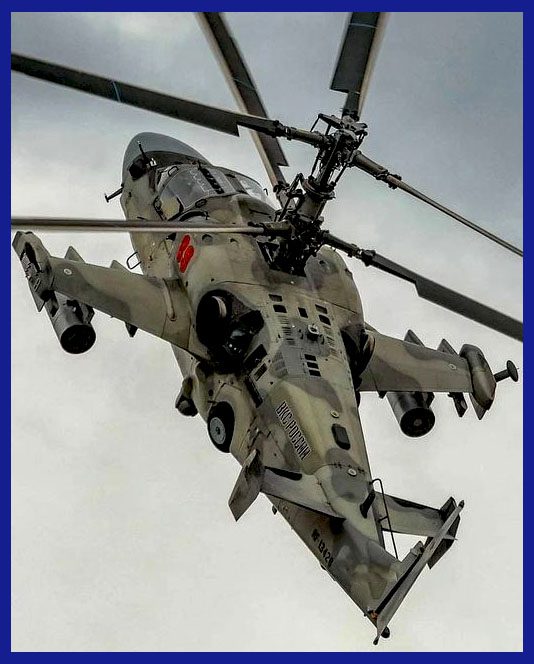
The Concept Behind The Development Of The Ka-52 Alligator
Overall, the concept behind the development of the Ka-52 Alligator aimed to create a highly capable attack helicopter that combines advanced combat capabilities, all-weather operations, manoeuvrability, crew safety, and versatility. These elements synergistically make the Ka-52 Alligator a formidable asset for modern military forces striving to maintain air superiority and execute successful operations on the battlefield. Hence, let us delve into the past and comprehensively explore every aspect, ranging from the inception of this military helicopter to its current iterations and variations.

The First Version of the Ka-50 Black Shark
It stands as the culmination of the V-80 prototype’s development. The Soviet Council of Ministers officially commissioned the production of this exceptional attack helicopter in 1987. Operational testing conducted from 1985 to 1986 revealed that the pilot’s workload closely resembled that of a fighter-bomber pilot, allowing them to seamlessly handle both flying and navigation responsibilities. Embracing Kamov’s renowned coaxial contra-rotating rotor system, akin to other Kamov helicopters, the Ka-50 eliminates the need for a conventional tail rotor assembly, resulting in improved aerobatic capabilities.
This unique configuration enables the aircraft to execute impressive manoeuvres such as loops, rolls, and strafing, maintaining a continuous line of sight with the target while gracefully manoeuvring in circular patterns at varying altitudes and speeds. By omitting the traditional tail rotor, the Ka-50 gains a distinct advantage as it eliminates the torque-countering mechanism, which can consume up to 30% of the engine’s power. Moreover, the Ka-50’s compact transmission system offers a relatively small target to ground-based threats, further enhancing its survivability on the battlefield.
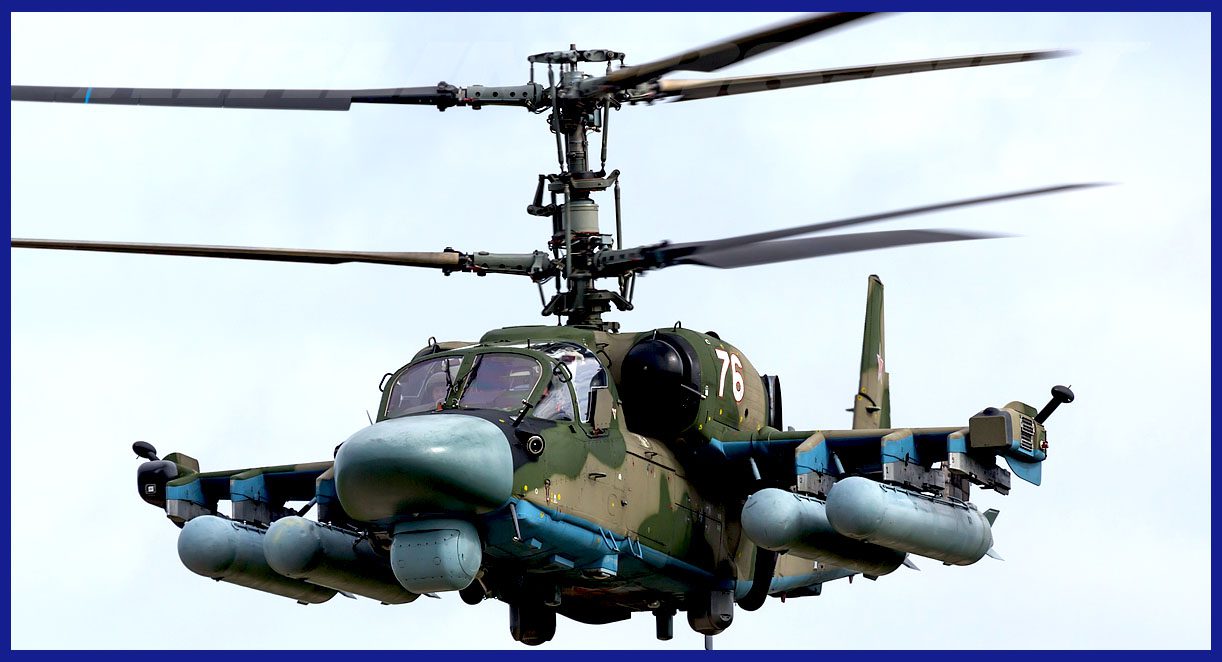
For enhanced pilot survivability, the Ka-50 is equipped with the NPP Zvezda K-37-800 ejection seat, a remarkable feature rarely seen in helicopters. Prior to the deployment of the rocket in the ejection seat, explosive charges within the rotor disc forcefully blow away the rotor blades, while the canopy is simultaneously jettisoned. Following successful initial flight testing and comprehensive system evaluations, the Council issued an order for the first batch of helicopters in 1990.
The attack helicopter was publicly introduced as the “Ka-50 Black Shark” in March 1992. In November 1993, four production helicopters were transported to the Army Aviation Combat Training Centre at Torzhok, marking the initiation of field trials. On 28 August 1995, the President of the Russian Federation granted authorization for the deployment of the Ka-50 within the Russian Army. However, the collapse of the Soviet Union resulted in a drastic reduction in defence procurement, leading to the delivery of only a dozen Ka-50s instead of the originally planned several hundred, intended to replace the Mil Mi-24.
The Ka-50, along with its variants, has been designated as the dedicated support helicopter for special forces, while the Mil Mi-28 has become the primary gunship for the army. Production of the Ka-50 was resumed in 2006, and in 2009, the Russian Air Force received three units constructed from incomplete airframes dating back to the mid-1990s.

The Second Version of Ka-50N and Ka-50Sh ” Night Shark “
Initially, the Ka-50N variant was intended to be equipped with the Merkury Low-Light TV ( LLTV ) system. However, due to insufficient funding, the development of the system faced delays and encountered issues related to reliability and capability. Consequently, the focus shifted towards forward-looking infrared ( FLIR ) systems. In 1993, Kamov presented a design that incorporated the Shkval-N sighting system featuring an infrared sensor. Numerous variants were tested during trials, eventually leading to the development of two “final” versions: the Ka-50N, known as the “Night Shark,” and the Ka-50Sh, referred to as the “ball” due to its spherical FLIR turret.
The inaugural flight of the first Ka-50Sh, which was the 8th pre-production aircraft, took place on 4 March 1997. The Kamov company and Black Shark logos were prominently displayed on the endplate fins and vertical tail. The aircraft showcased the Samshit-50 system housed within a 25-inch diameter sphere located under the nose, while the Shkval system was relocated to the nose cone area. Despite these developments, neither of the Ka-50 night-attack versions progressed to full-scale production.

The Ka-50-2 Erdogan: Unveiling the Third Version
In 1997, Israel Aerospace Industries ( IAI ) and the Kamov bureau collaborated to participate in a Turkish design competition with the Ka-50-2 Erdogan, alongside other contenders. The Ka-50-2 Erdogan was specifically developed as a tandem cockpit variant of the Ka-50 helicopter. It boasted a modern “glass cockpit” avionics system, sourced from Israel, and featured a turret-mounted folding 30 mm cannon to ensure landing clearance, contrasting the fixed cannon found on the Ka-50. With combat-proven avionics and advanced anti-tank-guided missiles, the helicopter demonstrated exceptional combat effectiveness. It was equipped with IAI’s flexible modular avionics suite, enabling easy customization to meet the operational requirements of the Tactical Leadership Programme ( TLF ) while providing room for growth.
Initially, Turkey opted for an improved version of the Bell AH-1 SuperCobra, disregarding alternatives such as the Erdogan, Eurocopter Tiger, AH-64 Apache, Denel Rooivalk, and A129 Mangusta. Ultimately, in 2007, the contract was awarded to the A129 Mangusta.

The Ka-52 Alligator: Unveiling the Fourth Version
In comparison to the original Ka-50, the Ka-52 Alligator features a “softer” nose profile and a radar system equipped with two antennas. The mast-mounted antenna is used for tracking aerial targets, while the nose-mounted antenna is utilized for ground targets. Additionally, the Ka-52 is equipped with a day-and-night TV/thermal sighting system housed in two spherical turrets—one positioned over the cockpit and the other located under the nose. The side-mounted cannon of the original Ka-50 is also retained in the Ka-52. Furthermore, the Ka-52 is outfitted with six wing-mounted hardpoints, providing additional versatility compared to the four hardpoints on the Ka-50.

To maintain weight and performance comparable to the Ka-50, certain modifications were made. The armour and capacity of the cannon magazine/feed were reduced, and as a result, some flight parameters suffered. The rate of climb decreased from 10 to 8 m/s, and the maximum positive load factor was limited to 3.0 g. However, many of these issues were resolved with the installation of the new VK-2500 engine. The Ka-52 is certified for operations in day, night, and adverse weather conditions.
The production of the first Ka-52 airframe commenced in mid-1996, and series production began in 2008. Following the completion of state trials, the Ka-52 officially entered service in May 2011, with the initial operational units joining the Russian Air Force during the same month. According to the previous State Defense Procurement Plans, the Russian Armed Forces were expected to receive 2 experimental and 24 serial Ka-52 helicopters by 2012.
Furthermore, a second long-term contract was signed in 2011, worth 120 billion rubles, aiming to provide the Russian Aerospace Forces with a total of 146 Ka-52 helicopters by 2020.

The Ka-52 Nile Crocodile: The Fifth Version Designed for Export to Egypt
In 2015, Egypt signed a deal to purchase 46 Ka-52 helicopters, with the contract expected to be fulfilled by 2020. Russian Helicopters began production of the first export models in early 2017, doubling overall production to meet the increased demand. The initial delivery of three Ka-52 attack helicopters was made to Egypt in July 2017, followed by an additional batch of three helicopters in August. By the end of 2017, Egypt had received a total of 19 Ka-52s.
The Egyptian version of the Ka-52, known as the Nile Crocodile, is a modified variant based on the standard Ka-52 Alligator used by the Russian Aerospace Forces. The Egyptian model incorporates anti-corrosion materials and a reinforced fuselage structure. It also features upgraded landing gear and wheels to accommodate the increased takeoff weight. The avionics have been updated, and a new cooling system has been installed to ensure optimal performance in hot climates. Deputy Prime Minister of Russia on Defence and space industry, Dmitry Rogozin, proposed the name “Nile Crocodile” for this version.
To enhance its defensive capabilities against guided missiles, the Nile Crocodile helicopters are equipped with President-S airborne defence systems. These systems include radar and laser warning receivers, Missile Approach Warning System ( MAW ) sensors, chaff/flare dispensers, as well as Electronic Countermeasure ( ECM ) and Directional Infrared Counter Measures ( DIRCM ) jammers. Unlike the standard Russian sets, the Egyptian Ka-52s feature two new DIRCM sets installed on each side of the fuselage. Additionally, the Russian laser-warning system has been replaced with an L-150 Pastel radar warning receiver.
Furthermore, Egypt has chosen to equip its Ka-52 helicopters with Russian anti-tank-guided missiles.

The Ka-52K ‘Katran’ is a navalized version derived from the Ka-52 and has been chosen as the new ship-borne attack helicopter for the Russian Naval Aviation. It incorporates various features such as folding rotor blades, folding wings, and reinforced landing gear. Compared to the land-based variants, the Ka-52K has shorter wings, resulting in four weapons pylons instead of six. It is equipped with and capable of utilizing anti-ship missiles, specifically the Kh-35 and Kh-38. The inaugural flight of one of the four Ka-52Ks ordered by the Russian Navy occurred on 7th March 2015. Following successful completion of all tests, the Ka-52K is now ready for serial production as of September 2020.
Reports from various media sources, including the SCMP, indicate that China is contemplating the procurement of 36 Ka-52Ks for deployment on the Type 075 helicopter carrier. This potential acquisition would significantly bolster the carrier’s heavy attack helicopter capabilities, which are currently lacking.
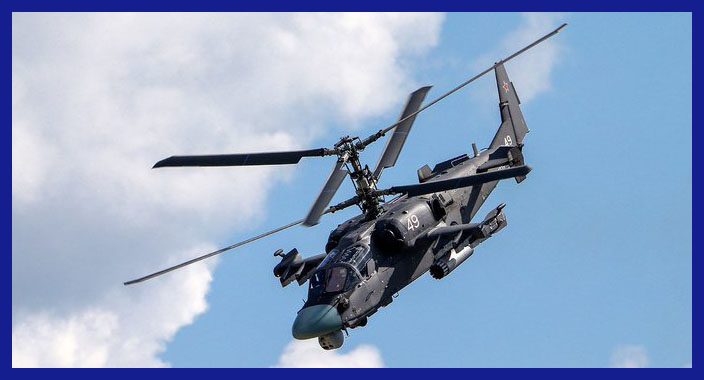
The Kamov Ka-52M: The Latest Updated Version as of 2023
The Russian Ministry of Defence announced a new version of the helicopter in 2018, which has now been realized as the Ka-52M. The plan is to acquire a total of 114 helicopters of this new version, while also upgrading the older Ka-52 helicopters to the Ka-52M standard. The contract for the initial 30 Ka-52Ms was signed in August 2021, and a subsequent contract was signed in August 2022 for the upgrade of all helicopters. The Ka-52M incorporates various upgrades, including a modernized electro-optical targeting turret with an extended range, reinforced undercarriage wheels, and improved cockpit ergonomics to enhance the use of night-vision goggles.
Additionally, the helicopter’s armament options now include the LMUR missile, and there are considerations for several new radar types. The Ka-52M will also feature a new self-protection system and will be adapted to operate within a new battlefield command and control system. According to TASS, the Russian military received its first batch of 10 modified Ka-52M helicopters on January 4, 2023.

The Analysis Of The Kamov Ka-52 Design
The Kamov Ka-52 design reveals several key aspects that contribute to its exceptional performance and capabilities
Coaxial Rotor System: The Ka-52 features a distinctive coaxial rotor system, characterized by two counter-rotating main rotors. This design eliminates the need for a tail rotor, resulting in enhanced manoeuvrability, agility, and stability. With a hovering ceiling of 4,000 m and a vertical rate of climb of 10 m per second at an altitude of 2,500 m, the coaxial rotor configuration showcases impressive performance. The rotor blades are constructed using polymer materials. Compared to single-rotor helicopters with tail rotors, the Ka-52’s coaxial-rotor setup yields significantly reduced moments of inertia relative to vertical and lateral axes, by approximately 1.5 to two times.
By eliminating the tail rotor, the helicopter can execute flat turns across its entire speed range. With a maximum vertical load factor of 3.5 g and low moments of inertia, the Ka-50 exhibits exceptional agility. The coaxial rotor system enables precise manoeuvring, high-speed flight, and effective operations in confined spaces, showcasing its versatility.
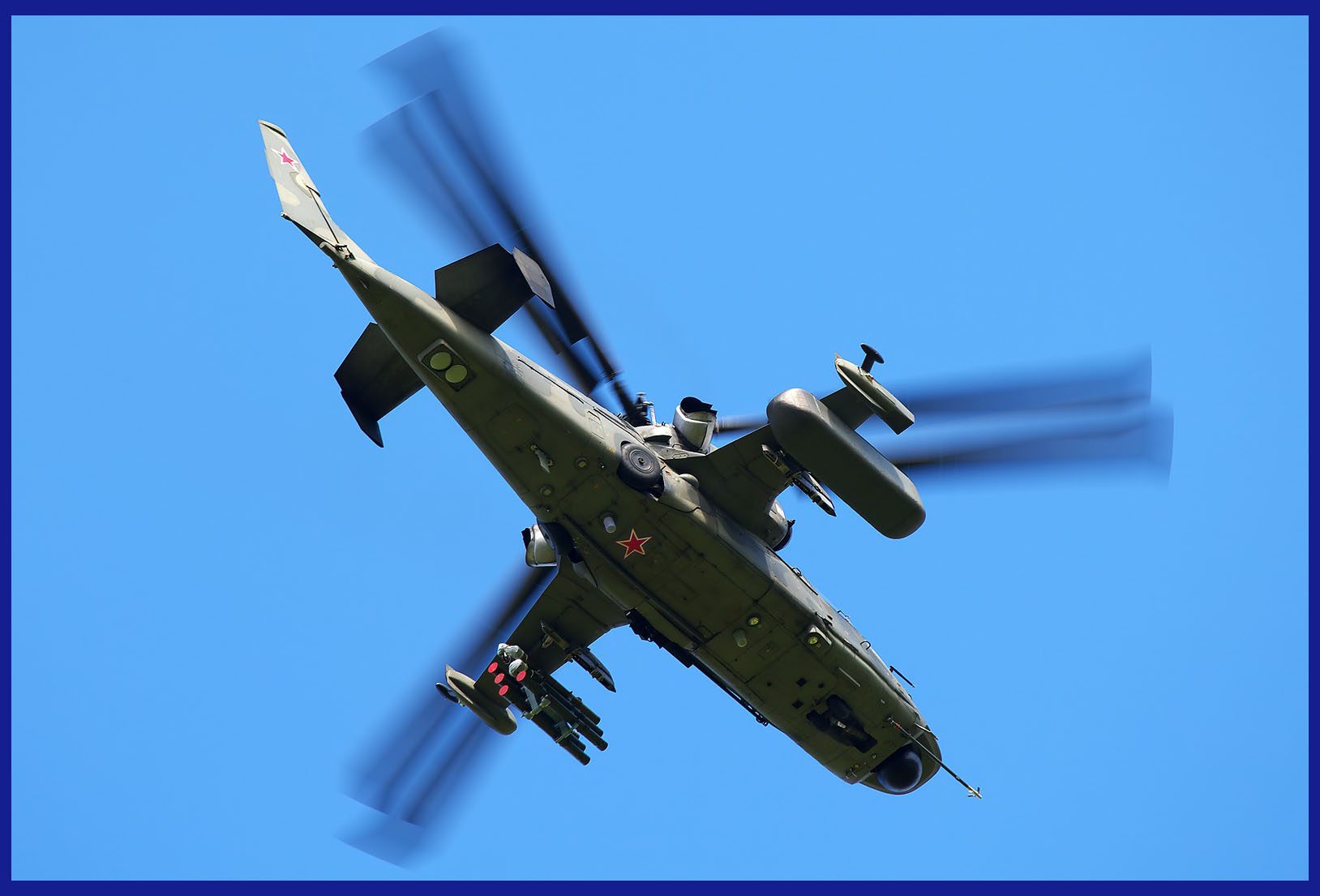
Tandem Cockpit Configuration: The Ka-52 incorporates a tandem cockpit configuration, where the pilot and weapons systems officer are seated one behind the other. This layout ensures optimal visibility for both crew members, promoting effective coordination and communication during missions. It facilitates efficient distribution of workload and enhances overall situational awareness. Additionally, the Ka-52 is equipped with a “Phazotron” cockpit radio-locator, enabling flights in adverse weather conditions and during nighttime operations.
The vital information gathered by the radio locator is relayed to the cockpit’s multi-functional display screen. To engage in combat, both pilots are equipped with range-finders integrated into their helmets, and they can utilize night vision eyepieces for nocturnal flights. The cockpit is fortified with comprehensive all-around armour, offering protection to the pilot against 12.7 mm armour-piercing bullets and 23 mm projectile fragments. Moreover, the rotor blades are designed to withstand multiple hits from ground-based automatic weapons.
Avionics and Sensor Systems: The Ka-52 is equipped with state-of-the-art avionics and sensor systems that significantly enhance its combat capabilities. The flight systems comprise an inertial navigation system ( INS ), autopilot, and head-up display ( HUD ), which contribute to precise navigation and flight control. Sensor systems include forward-looking infrared ( FLIR ) and terrain-following radar, enabling the helicopter to operate effectively in various environments.

Additionally, the Ka-52 features a comprehensive array of sensors, such as electro-optical targeting systems, radar systems, and helmet-mounted target designation systems. These advanced systems provide the crew with superior situational awareness, facilitating efficient target acquisition and engagement. Moreover, the Ka-52 is equipped with an electronic radio and sighting-piloting-navigating system that enables day and night flights in both visual flight rules ( VFR ) and instrument flight rules ( IFR ) weather conditions.
This innovative avionics system is characterized by precise target designation and a digitally coded communication system, enabling the exchange of crucial information, including precise enemy coordinates, between helicopters flying at considerable distances from each other and ground command posts.
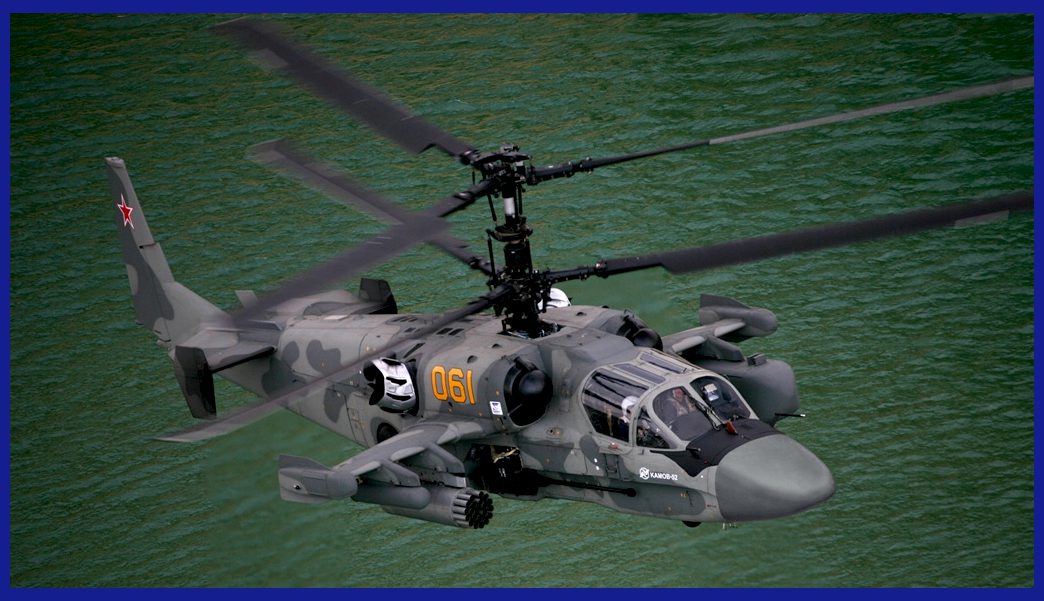
Composite Materials, Armor, and Ejection Mechanism: The Ka-52 incorporates advanced composite materials in its construction, providing an exceptional balance of strength and lightness. These cutting-edge materials significantly enhance the helicopter’s durability, offering reliable protection while maintaining a lightweight structure. Additionally, the helicopter is equipped with robust armour plating, ensuring comprehensive defence against small arms fire and shrapnel, thereby safeguarding both the crew and critical systems.
Notably, the Ka-52 stands as the world’s first operational helicopter to feature a rescue ejection system, a pioneering advancement in helicopter technology. This groundbreaking system enables the pilot to safely eject at any altitude and speed. Prior to ejection, the rotor blades detach using explosive bolts, ensuring the crew’s safety throughout the entire process. The remarkable safety mechanism of the K-37-800 rocket-assisted ejection system, developed by the Zvezda Research and Production company in the Moscow region, underscores the helicopter’s commitment to pilot safety.
Overall, The analysis of the Kamov Ka-52 design highlights its well-engineered features, which enable it to excel in a wide range of combat missions. From its coaxial rotor system to its advanced avionics and weapon integration, the design of the Ka-52 ensures exceptional performance, manoeuvrability, and firepower, making it a formidable attack helicopter.

The Kamov Ka-52: History Of Operations As Of 2023
Russian military action in Second Chechen War
During the Second Chechen War, the Ka-50 played a significant role in the Russian Army’s operations against separatists in the Chechen Republic. In December 2000, two production Ka-50 helicopters arrived in the area along with a Ka-29 for reconnaissance and target designation. On January 6, 2001, the Ka-50 engaged in live combat, using weapons against the enemy for the first time.
On January 9, in the mountainous region near Komsomolskoye, a Ka-50 accompanied by a Mi-24 destroyed an ammunition warehouse belonging to Chechen insurgents using unguided rockets. In February, the strike group comprising two Ka-50s and one Ka-29 successfully discovered and destroyed a fortified insurgent camp using guided missiles. These missions showcased the Ka-50’s airframe, systems, and armament, highlighting its effectiveness in challenging mountainous terrain.
Russian military action in Syria
During the Russian military intervention in the Syrian Civil War in 2015, Ka-52 helicopters were deployed. They played a vital role in defending the Russian base in Latakia, providing escorts for search and rescue helicopters, and supporting Russian special forces. Furthermore, these helicopters actively participated in the 2017 Palmyra offensive. These instances highlight the substantial contribution of Ka-52 helicopters in the Syrian conflict, underscoring their effectiveness in combat operations.

Russian military action in Ukraine in 2022:
During the early phases of the 2022 Russian invasion of Ukraine on 24 February, a strategic decision was made to deploy multiple older versions of the Ka-52, including the Ka-50. Despite the significant threat posed by Ukraine’s advanced Surface-to-Air ( SAM ) systems acquired from NATO, these resilient helicopters were selected for their exceptional combat capabilities. Following initial losses, the Russian forces adeptly utilized the Ka-52s with devastating effectiveness, precisely targeting and eliminating critical Ukrainian positions. As of 30th May 2023, the Ka-52s continue to play a pivotal and indispensable role in the ongoing conflict, further highlighting their unrivalled power and prowess.
Technical Specifications Of The Kamov Ka-52 Alligator
- Crew: 2 ( pilot & gunner )
- Length: 52 ft 6 in ( 16 m ) with rotors
- Height: 16 ft 2 in ( 4.93 m )
- Wingspan: 24.08 ft ( 7.34 m )
- Empty Weight: 7,690 kg (16,953 lb)
- Gross Weight: 9,800 kg ( 21,605 lb )
- Power plant: 2 × Klimov VK-2500 turboshaft engines, 1,800 kW ( 2,400 shp ) each
- Main rotor diameter: 2 × 14.5 m ( 47 ft 7 in )
- Main rotor area: 330.3 m2 ( 3,555 sq ft ) contra-rotating 3-bladed main rotors
- Maximum Speed: 315 km/h ( 196 mph )
- Average Cruise speed: 270 km/h ( 170 mph )
- Ferry Range: 1,160 km ( 720 mi )
- Combat range: 510 km ( 317 m )
- Service ceiling: 18,000 ft ( 5,500 m )
- Rate of climb: 3,150 ft/min ( 16 m/s )
- Armament: 1 × mobile semi-rigid 30 mm Shipunov 2A42 cannon ( 460 rounds total ), Total of Eight Hardpoints: 6 under-wing and 2 on wingtips for countermeasures or air-to-air missiles, with a capacity of 2,000 kg, and provisions to carry combinations of, 80 mm and 122 mm Rockets, 9k121 Vikhr Anti-tank missiles, R-60, R-73, Igla Air-to-Air Missile / LMUR, Kh-35 Air-to-Surface missile / KAB-500Kr Bombs and 4 UV-26 dispensers each ( total 32 chaff/flare cartridges in each pod )

“Moreover, you can purchase an exclusive book about the Kamov Ka-52 story on Amazon by following this link. Additionally, don’t miss the opportunity to acquire exquisite large-scale 1/72 premium diecast models of the formidable Su-57, Su-30MKI, Su-34, Su-35 and MiG-29 fighter jets. These remarkable aircraft are now conveniently available on Air Models. Click here to access these exceptional models. Renowned for their devastating capabilities in combat, these fighter jets showcase the pinnacle of modern aerial warfare technology.”
In conclusion, the Kamov Ka-52 Alligator stands out as a highly capable and versatile anti-tank attack helicopter with a well-engineered design. Its coaxial rotor system provides exceptional manoeuvrability and stability, while the tandem cockpit configuration ensures optimal visibility and effective crew coordination. The use of composite materials and armour strikes a balance between strength and weight, enhancing the helicopter’s durability and protection.
The advanced avionics and sensor systems, coupled with versatile weapons integration, offer superior situational awareness and firepower for a range of missions. With enhanced survivability features and adaptability, the Ka-52 Alligator showcases its prowess as a formidable asset on the modern battlefield. Its design reflects the meticulous attention to detail and engineering excellence that has made it a prominent member of the Kamov helicopter family.
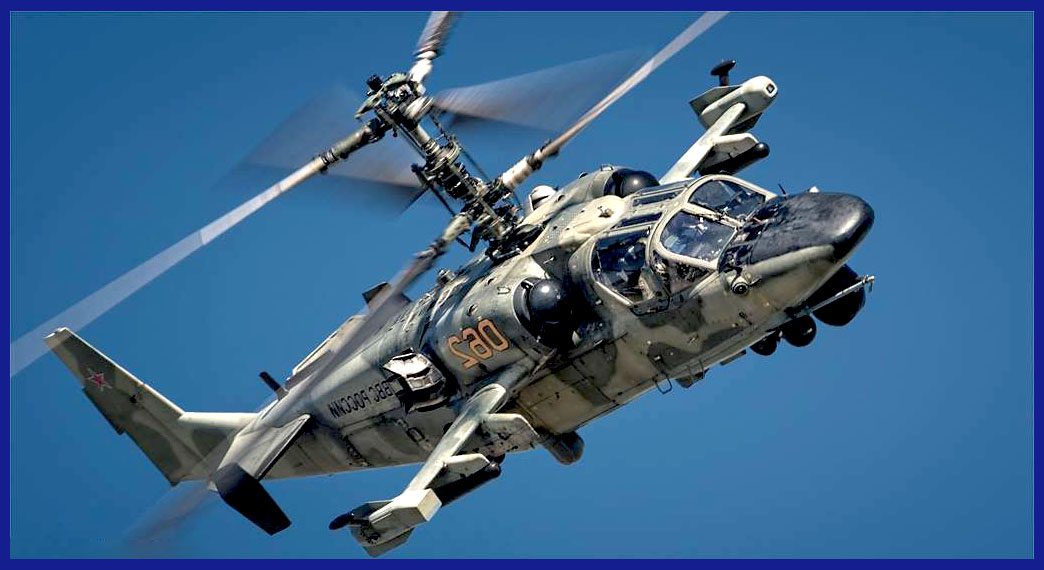
Important Announcement for Our Valued Readers!
After an article is published, it is possible that updates or changes may have occurred beyond the time of publication. Therefore, it is important to be aware that certain information in the article might be outdated. To ensure the most accurate analysis, it is highly recommended to verify the content with the latest sources available.
However, we are dedicated to delivering outstanding articles on military products and global updates. Maintaining quality and smooth operation requires resources. Your support sustains our efforts in providing insightful content. By purchasing high-quality products through our affiliated links, you help us keep our platform alive and acquire top-notch items. Your unwavering support is invaluable and inspires us to strive further.
We welcome your suggestions and requests for more information, as we value feedback from our readers. If there’s specific defence material or equipment not covered on our site, please share your request in the comments. We’ll strive to research and provide the required information. We sincerely thank you for your unwavering interest in our website, and we eagerly anticipate hearing from you! Enjoy your reading experience!